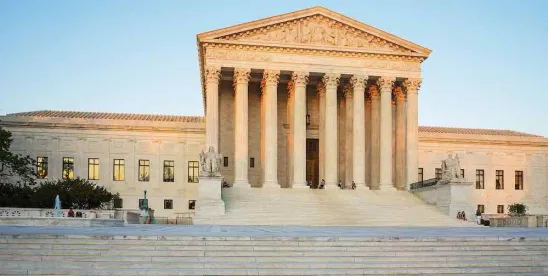The Supreme Court’s day started with the specter of yet another leak of a reproductive rights decision having occurred.
The day ended with the Court’s actually deciding the case, providing a small bit of good news for the pro-choice side of things and representative, as was the case with the recent gun decision, of a tendency among certain Justices, e.g., Barrett and Kavanaugh, to temper earlier rulings.
It also appears that the Court won’t decide Trump v. U.S. until after tonight’s presidential campaign debate. The Loper case, revisiting the Chevron doctrine, also remains pending.
There will be decisions issuing tomorrow, the notional last day of the term, but it will surprise no one if the term is extended into July.
Now for the day’s actual business.
The Court started with Ohio v. Environmental Protection Agency, in which a 5–4 majority stayed the Environmental Protection Agency’s so-called “Good Neighbor Rule,” intended to address interstate air pollution. The case was unusual in that the Court heard arguments without having granted cert. Another unusual feature is the fact that while Justice Gorsuch wrote for the Court and was joined by the Chief Justice and Justices Thomas, Alito, and Kavanaugh, Justice Barrett dissented, along with the three Court “liberals.” The case itself involves so-called State Implementation Plans directed at compliance with the Clean Air Act with respect to airborne pollution being carried across state borders. Finding that 23 states had not satisfied the statutory requirements, the EPA exercised its power, through a rulemaking procedure, to impose a Federal Implementation Plan (FIP). The subject states sued, seeking a stay of the FIP, alleging that it violated the Administrative Procedure Act by usurping the authority of the states and because of unresolved technical issues relating to the application of the rule. Justice Gorsuch began the majority opinion by reciting the familiar criteria for the issuance of stays:
In deciding whether to issue a stay, we apply the same “sound . . . principles” as other federal courts. Nken v. Holder, 556 U. S. 418, 434 (2009) (internal quotation marks omitted). Specifically, in this litigation, we ask (1) whether the applicant is likely to succeed on the merits, (2) whether it will suffer irreparable injury without a stay, (3) whether the stay will substantially injure the other parties interested in the proceedings, and (4) where the public interest lies.
Holding that the state and industry plaintiffs were likely to succeed on the merits, especially with regard to the efficacy and economic impact of the EPA’s plan, and because the agency’s responses to comments were otherwise problematic, the Court granted the stay and remanded the case to the U.S. Court of Appeals for the District of Columbia Circuit for review of the petitioners’ claims. The Court anticipates that its stay order will be affected by its ultimate grant or denial of certiorari.
Justice Barrett’s dissent criticizes the Court’s “grant[ing] emergency relief in a fact-intensive and highly technical case without fully engaging with both the relevant law and the voluminous record.” We can end this discussion by noting that this is yet another case where a federal administrative agency is being given a short leash with respect to its supposed technical expertise. Chevron doesn’t enter into the decision, but does it presage further limitations on agencies when Loper is finally decided? We shall see, perhaps as early as tomorrow.
Justice Gorsuch also wrote for a 5–4 majority in Harrington v. Purdue Pharma L.P., rejecting the proposed $6 billion settlement of the mass of litigation brought against the manufacturer of the opioid drug OxyContin. Joined by Justices Thomas, Alito, Barrett, and, again surprising her liberal followers, Jackson, Justice Gorsuch opined that “the bankruptcy code does not authorize a release and injunction that, as part of a plan of reorganization under Chapter 11 of the bankruptcy code, effectively seek to discharge claims against a non-debtor without the consent of affected claimants.” Among other things, the net of the Court’s decision exposes the Sackler family, whose potential benefits from the settlement caught much of the Court’s attention, to substantial potential liability. This time, the “conservative” dissenter was Justice Kavanaugh, joined by the Chief Justice, Justice Sotomayor, and as is often the case lately with Kavanaugh, by Justice Kagan. The dissent cites the “devastating [consequences] for the more than 100,000 opioid victims and their families” and claims the decision improperly “restricts the long-established authority of bankruptcy courts to fashion fair and equitable relief for mass-tort victims.”
Securities and Exchange Commission v. Jarkesy presents the stereotypical 6–3 split between Court conservatives and liberals and provides another example of the Court’s limiting the power of the administrative state. Writing for the conservative majority, the Chief Justice opined that “[w]hen the SEC seeks civil penalties against a defendant for securities fraud, the Seventh Amendment entitles the defendant to a jury trial.” This “straightforward” resolution of post-Dodd-Frank Act SEC house administrative trials, in which certain investment advisors were charged with securities fraud, follows the analysis of several previous Court cases implicating “the Seventh Amendment because the SEC’s antifraud provisions replicate common law fraud. And the ‘public rights’ exception to Article III jurisdiction does not apply, because the present action does not fall within any of the distinctive areas involving governmental prerogatives where the Court has concluded that a matter may be resolved outside of an Article III court, without a jury.” As the Chief Justice sees it, the dissenters “would permit Congress to concentrate the roles of prosecutor, judge, and jury in the hands of the Executive Branch. That is the very opposite of the separation of powers that the Constitution demands.” The liberal dissenters disagree, asserting that, historically, Congress has authorized administrative agency adjudications of civil penalty claims belonging to the government. Are federal judges now likely to see a flood of jury trials where regulatory agencies, not just the SEC, are seeking financial penalties? We shall see.
Finally for the day, the Court officially dealt with the matter that was erroneously posted yesterday: the claim that Idaho’s extremely restrictive abortion statute is preempted by the Emergency Medical Treatment and Labor Act (EMTALA), 42 U. S. C. §1395dd. The operative decision in Moyle v. United States and Idaho v. United States is a mere three-line per curiam order dismissing as improvidently granted the writ of certiorari before judgment and related stays previously entered by the Court. A well-known media commentator yesterday said he believes that the Court is now, like Caesar’s Gaul, divided into three parts. The opinions that follow the brief order, “digging” the case, support that view. From the left, Justice Kagan’s concurrence summarizes the “liberal” take on the matter. Speaking for herself and Justices Sotomayor and Jackson (who also separately wrote, concurring and dissenting in parts), Justice Kagan writes:
I concur in the Court’s decision today to vacate its stay and dismiss the writ of certiorari before judgment as improvidently granted. I do so because Idaho’s arguments about EMTALA do not justify, and have never justified, either emergency relief or our early consideration of this dispute. With this Court’s writ of certiorari dismissed, the lower courts can proceed with this litigation in the regular course. And with this Court’s stay dissolved, the District Court’s preliminary injunction will again take effect. That will prevent Idaho from enforcing its abortion ban when the termination of a pregnancy is needed to prevent serious harms to a woman’s health.
Kagan’s opinion accurately describes the new status quo.
In the middle, we have Justice Barrett concurring for herself, the Chief Justice, and Justice Kavanaugh because the scope of the cases has shifted so much since cert. was granted. According to the concurring opinion:
The parties dispute whether EMTALA requires hospitals to provide abortions—or any other treatment forbidden by state law—as necessary stabilizing care. They also disagree about whether EMTALA, as a statute enacted under Congress’s spending power and that operates on private parties, can preempt state law (an issue aired for the first time in this Court). In my judgment, it would be imprudent to answer these important questions now. Since this suit began in the District Court, Idaho law has significantly changed—twice. And since we granted certiorari, the parties’ litigating positions have rendered the scope of the dispute unclear, at best.
On the right, Justice Alito, along with Justices Thomas and Gorsuch, recall the sweep of the Court’s holding in Dobbs and assert that “the Government’s new interpretation of EMTALA is refuted by the statutory text, the context in which the law was enacted, and the rules of interpretation that we apply to Spending Clause legislation. We should reject the Government’s interpretation and put that matter to rest.” Well, there is no ultimate rest, just a respite as the case returns to the Ninth Circuit while, for now, Idaho cannot enforce its very severe law.
As to respites, we have one for the rest of this day. But the Court will be issuing opinions again tomorrow, and we shall be attentive.




 />i
/>i

